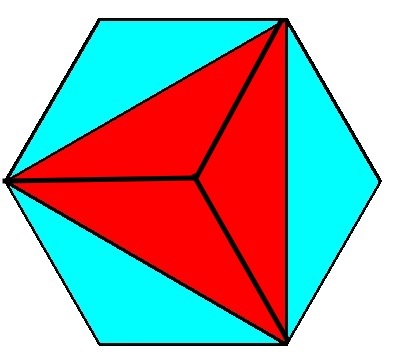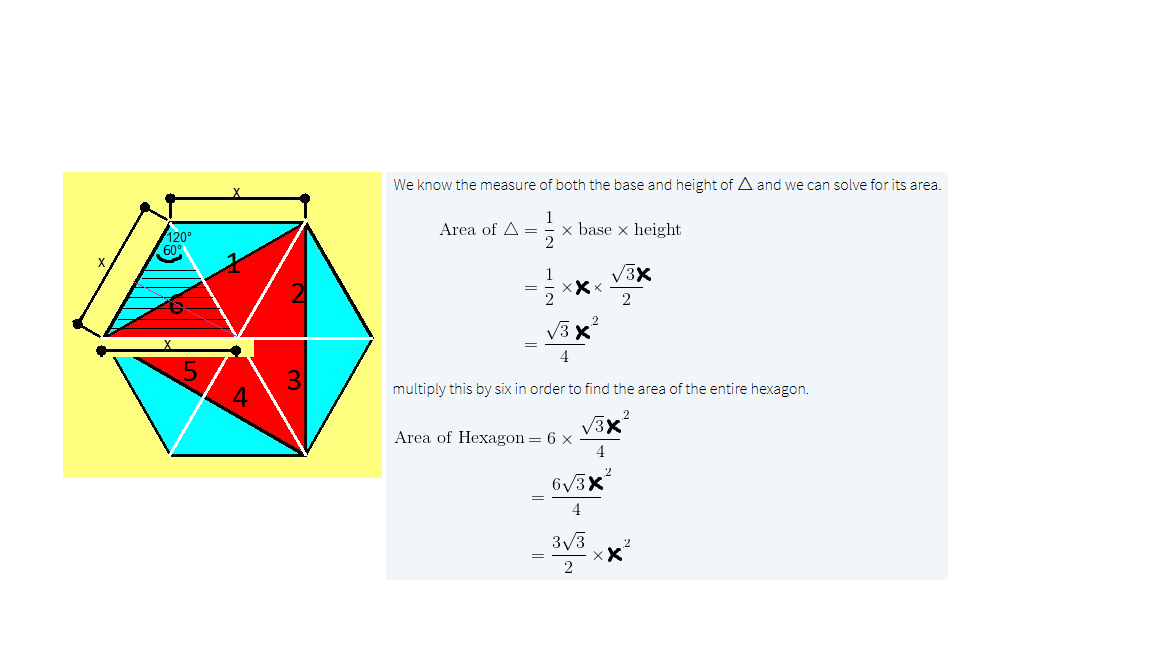Regular hexagon
Shown to the right is a regular hexagon.
Which region has a greater area?
This section requires Javascript.
You are seeing this because something didn't load right. We suggest you, (a) try
refreshing the page, (b) enabling javascript if it is disabled on your browser and,
finally, (c)
loading the
non-javascript version of this page
. We're sorry about the hassle.
5 solutions
👍 Yes. It's great
Draw lines equal in length to the lines creating the red triangle, and observe:

From this we find that the original lines divide the three parallelograms to create the hexagon in half, by bisecting the shapes. Because 1 / 2 + 1 / 2 = 1 , we know that the two colored divisions are equal.
 A
h
e
x
a
g
o
n
=
2
3
3
x
2
A
h
e
x
a
g
o
n
=
2
3
3
x
2
Now, length of side of red triangle = s = 3 x (twice the height of one of the six smaller equilateral triangles in diagram above)
Height of red triangle = h:
∴
(
2
3
x
)
2
+
h
2
=
3
x
∴ 4 3 x 2 + h 2 = 3 x 2
∴ h 2 = 3 x 2 − 4 3 x 2 ∴ h 2 = 4 9 x 2 ∴ h = 2 3 x
A r e d = 2 s h = 2 3 x 2 3 x = 4 3 3 x 2 = 2 A h e x a g o n
A b l u e = A h e x a g o n − A r e d = 2 A h e x a g o n ∴ A r e d = A b l u e
Fold the blue triangles into the center. Since the hexagon angles are 120° and the triangle angles are 60°, they'll fit perfectly.
Let s be the side of the hexagon, and d be the chord joining every other vertex, The angle formed by adjacent hexagon sides, t = 4 180/6 = 120. The area of the blue part = 3 (1/2)s^2 sin(120) =[3 sqrt(3)/4] s^2. By the law of cosines, d^2 = s^2 + s^2 -2 s^2 cos(120) = 3s^2 The red area is an equilateral triangle with area = sqrt(3)/4 d^2 =[3 sqrt(3)/4] s^2, so they are equal. Ed Gray
A n o t h e r s o l u t i o n :
Let x be the side length of the regular hexagon. Then the area of the three blue isosceles triangles is A b l u e = 3 ( 2 1 ) ( x 2 ) ( sin 1 2 0 ) = 2 3 ( x 2 ) ( 2 3 ) = 4 3 x 2 3 .
Now the area of a regular hexagon is given by A h e x a g o n = 2 3 3 x 2 .
So the area of the red region is
A r e d = A h e x a g o n − A b l u e = 2 3 3 x 2 − 4 3 3 x 2 = 4 3 x 2 3
Hence, the areas are equal.